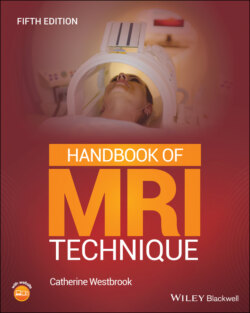Читать книгу Handbook of MRI Technique - Catherine Westbrook - Страница 30
SIGNAL‐TO‐NOISE RATIO (SNR)
ОглавлениеSNR is defined as the ratio of the amplitude of signal received by the receiver coil to the average amplitude of the noise. The signal is the voltage induced in the receiver coil, and the noise is a constant value depending on the area under examination and the background electrical noise of the system. SNR may be increased by using:
conventional spin echo (CSE) and fast or turbo spin echo (FSE/TSE) pulse sequences
a long repetition time (TR) and a short echo time (TE)
a flip angle of 90° in all spin echo type pulse sequences or the Ernst angle in gradient echo (GRE) pulse sequences
a well‐tuned and correctly sized receiver coil
a coarse matrix
a large FOV
thick slices
a narrow receiver bandwidth
high‐order signal averages (number of excitations (NEX)/number of signal averages (NSA)).
In Part 2, the following terms and approximate parameters are suggested when discussing the number of signal averages (NEX/NSA) (see also Table 2.1):
Short NEX/NSA is 1 or less (partial averaging).
Medium NEX/NSA is 2 or 3.
Long or multiple NEX/NSA is 4 or more.
